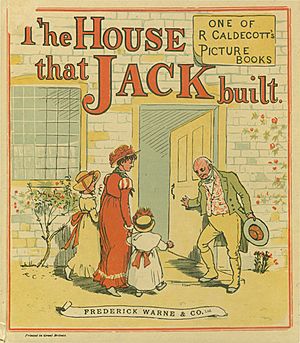Cumulative tale facts for kids
A cumulative tale is a special kind of story where actions or words keep repeating and building up. Think of it like adding one block at a time to a tower – each new part adds to what came before. These stories often have a simple plot, but they are fun because of their repetition and rhythm. They can be a bit like a tongue-twister! Sometimes, the story builds to a sudden ending, like in "The Gingerbread Man". Many cumulative tales are also cumulative songs or nursery rhymes. You might find them featuring a series of animals or even forces of nature, where each one is stronger than the last.
How Stories Are Grouped
Just like books in a library are organized, folk tales and stories are often grouped together. One way experts classify stories is using a system called the Aarne–Thompson–Uther Index. This system helps researchers study how stories are similar around the world. Cumulative tales have their own special place in this system.
Types of Cumulative Tales
Within this system, cumulative tales are often found in groups that involve:
- Chains of Events: These stories build up with numbers, objects, animals, or even names.
- Example: "The goat that would not go home" where someone tries to get a stubborn goat to move.
- Chains About Eating: Stories where characters eat more and more, or things happen around food.
- Example: "The Gingerbread Man" (also known as "The Fleeing Pancake") where a character runs away from everyone who wants to eat them.
- Chains About Other Events: Many different kinds of events can build up in these tales.
- Example: "This Is the House That Jack Built" which adds new details about the house and its inhabitants with each line.
- Example: "The Old Woman and Her Pig" where an old woman needs help from many different things to get her pig to move.
- Example: "Henny Penny" (also known as "The Sky Is Falling") where animals believe the sky is falling and gather more friends as they run.
Fun Examples of Cumulative Tales
You might already know many cumulative tales! They are popular because they are easy to remember and fun to tell. Here are some well-known examples:


